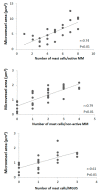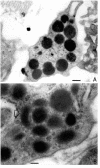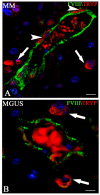Mast Cells and Angiogenesis in Human Plasma Cell Malignancies
- PMID: 30678047
- PMCID: PMC6386864
- DOI: 10.3390/ijms20030481
Mast Cells and Angiogenesis in Human Plasma Cell Malignancies
Abstract
Bone marrow angiogenesis plays an important role in the pathogenesis and progression of hematological malignancies. It is well known that tumor microenvironment promotes tumor angiogenesis, proliferation, invasion, and metastasis, and also mediates mechanisms of therapeutic resistance. An increased number of mast cells has been demonstrated in angiogenesis associated with hematological tumors. In this review we focused on the role of mast cells in angiogenesis in human plasma cell malignancies. In this context, mast cells might act as a new target for the adjuvant treatment of these tumors through the selective inhibition of angiogenesis, tissue remodeling and tumor-promoting molecules, permitting the secretion of cytotoxic cytokines and preventing mast cell-mediated immune suppression.
Keywords: angiogenesis; anti-angiogenesis; mast cells; multiple myeloma; plasmocytoma.
Conflict of interest statement
The authors declare no conflict of interest.
Figures




Similar articles
-
Angiogenesis in multiple myeloma.Chem Immunol Allergy. 2014;99:180-96. doi: 10.1159/000353312. Epub 2013 Oct 17. Chem Immunol Allergy. 2014. PMID: 24217610 Review.
-
Mast cells as therapeutic target in cancer.Eur J Pharmacol. 2016 May 5;778:152-7. doi: 10.1016/j.ejphar.2015.02.056. Epub 2015 Apr 24. Eur J Pharmacol. 2016. PMID: 25917325 Review.
-
New Insights in Anti-Angiogenesis in Multiple Myeloma.Int J Mol Sci. 2018 Jul 12;19(7):2031. doi: 10.3390/ijms19072031. Int J Mol Sci. 2018. PMID: 30002349 Free PMC article. Review.
-
Mast cells and macrophages exert beneficial and detrimental effects on tumor progression and angiogenesis.Immunol Lett. 2013 May;152(2):83-8. doi: 10.1016/j.imlet.2013.05.003. Epub 2013 May 15. Immunol Lett. 2013. PMID: 23685256 Review.
-
Mast cells in breast cancer angiogenesis.Crit Rev Oncol Hematol. 2017 Jul;115:23-26. doi: 10.1016/j.critrevonc.2017.04.009. Epub 2017 Apr 27. Crit Rev Oncol Hematol. 2017. PMID: 28602166 Review.
Cited by
-
Targeting angiogenesis in myocardial infarction: Novel therapeutics (Review).Exp Ther Med. 2022 Jan;23(1):64. doi: 10.3892/etm.2021.10986. Epub 2021 Nov 22. Exp Ther Med. 2022. PMID: 34934435 Free PMC article. Review.
-
Experimentally validated oxidative stress -associated prognostic signatures describe the immune landscape and predict the drug response and prognosis of SKCM.Front Immunol. 2024 Apr 10;15:1387316. doi: 10.3389/fimmu.2024.1387316. eCollection 2024. Front Immunol. 2024. PMID: 38660305 Free PMC article.
-
Controversial role of mast cells in NSCLC tumor progression and angiogenesis.Thorac Cancer. 2022 Nov;13(21):2929-2934. doi: 10.1111/1759-7714.14654. Epub 2022 Oct 4. Thorac Cancer. 2022. PMID: 36196487 Free PMC article. Review.
-
Survey of Mast Cell Density in Transitional Cell Carcinoma.Iran J Pathol. 2021 Spring;16(2):119-127. doi: 10.30699/IJP.2020.123562.2345. Epub 2020 Dec 20. Iran J Pathol. 2021. PMID: 33936222 Free PMC article.
-
CXCL6-CXCR2 axis-mediated PD-L2+ mast cell accumulation shapes the immunosuppressive microenvironment in osteosarcoma.Heliyon. 2024 Jul 8;10(14):e34290. doi: 10.1016/j.heliyon.2024.e34290. eCollection 2024 Jul 30. Heliyon. 2024. PMID: 39082021 Free PMC article.
References
-
- Klein B., Zhang X.G., Jourdan M., Content J., Houssiau F., Aarden L., Piechaczyk M., Bataille R. Paracrine rather than autocrine regulation of myeloma-cell growth and differentiation by interleukin-6. Blood. 1989;73:517–526. - PubMed
Publication types
MeSH terms
Substances
Grants and funding
LinkOut - more resources
Full Text Sources

